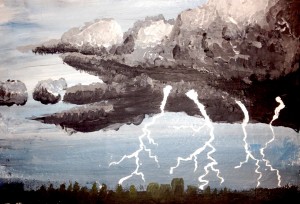
Johannesburg, South Africa: lightning strikes a 9-year-old brother and his sister who had gone out to play. The boy dies in transit to the hospital; the toddler girl is blinded. The same storm destroyed six houses and damaged another 36.
Johannesburg is a city self-proclaimed the “lightning capital of the world.” This is more of a concern than a commendation; the city saw 13 schoolchildren struck by lightning over the course of two days last February, and 14 miners struck last November. According to the South Africa Weather Service, these kinds of lightning-related tragedies result in a staggering 260 deaths a year.
This problem is not at all limited to South Africa. In India, a single lightning storm in October killed 32 people. In Nepal, the annual death-by-lightning toll reached 130 in 2012. Many other developing countries have high rates of death and injury by lightning; one estimate puts the worldwide rate at up to 24,000 deaths per year. In stark contrast, the United States recorded only 23 deaths by lightning in 2013. Why are developing countries losing so many more people to lightning?
Many of these countries have both a hot, humid climate and an agriculture-based economy, which increase the risk of lightning-related tragedies. A more substantial problem, however, is the lack of lightning awareness across both the scientific community and the general public. Recently, researchers have launched into studying how lightning affects the body and how lightning deaths can be prevented. Of course, many aspects of lightning safety have been established for decades, and the greater challenge facing scientists now is how to disseminate this information so people are more knowledgeable about the risks associated with charged weather.
Many people are simply unaware of the existing scientific literature. For a lightning strike, the worst-case scenario is a direct hit to the head, which happens in open spaces. Most of these victims will die instantly. However, if sheltered under a tree or similar structure, a person may be hit by a side flash in which the lightning first strikes the structure and then crosses over to the victim. These side flashes are often, but not always fatal.
Expanding lightning research should increase awareness of the dangers of lightning and reduce the lightning-related death toll. In South Africa, people educated and uneducated alike believe that a combination of natural and supernatural influences cause lightning attacks; witch-caused lightning supposedly targets only sinful people. Even among those who don’t believe in magic, similar superstition is ingrained. Estelle Trengove of the University of Witwatersrand — common known as Wits University — reports a few rampant beliefs: “If you are a boy, or you are wearing rubber-soled shoes, or if you are already wet, you will be safe.” Correcting misconceptions by disseminating long-established knowledge about the dangers of lightning will hopefully improve lightning safety in many developing nations.
Finding a safe place to shelter from lightning is another issue in lower-income countries. Many deaths in South Africa, for example, occur in wide-open rural spaces with no nearby shelter. Most shelters in the poorer parts of South Africa and other developing nations are made with hastily constructed metal roofs or even open-air designs. In the United States, people stuck in a storm can find refuge in their metal-framed cars; in most developing countries, people don’t have access to such vehicles.
While safety rules will circumstantially vary from place to place, there are a few universals like “never shelter under a tree” and “shelter inside a sturdy building.” Many countries are also taking their own steps toward educating the public. In South Africa, the Wits University team created a simple children’s videogame surrounding the topic of lightning safety. In Colombia, the military recently hired lightning specialists to instruct farmers on lightning safety in the field. Malaysia and other countries at high lightning risk are taking similar steps.
While it may take some time for the results of these efforts to pan out, Ken Nixon of Wits University believes that people are “really starting to understand the risks associated with storms.” Further research from Wits and other teams worldwide will hopefully improve knowledge and safety regarding lightning attacks. In the meantime, the best expert advice is to stay inside.
